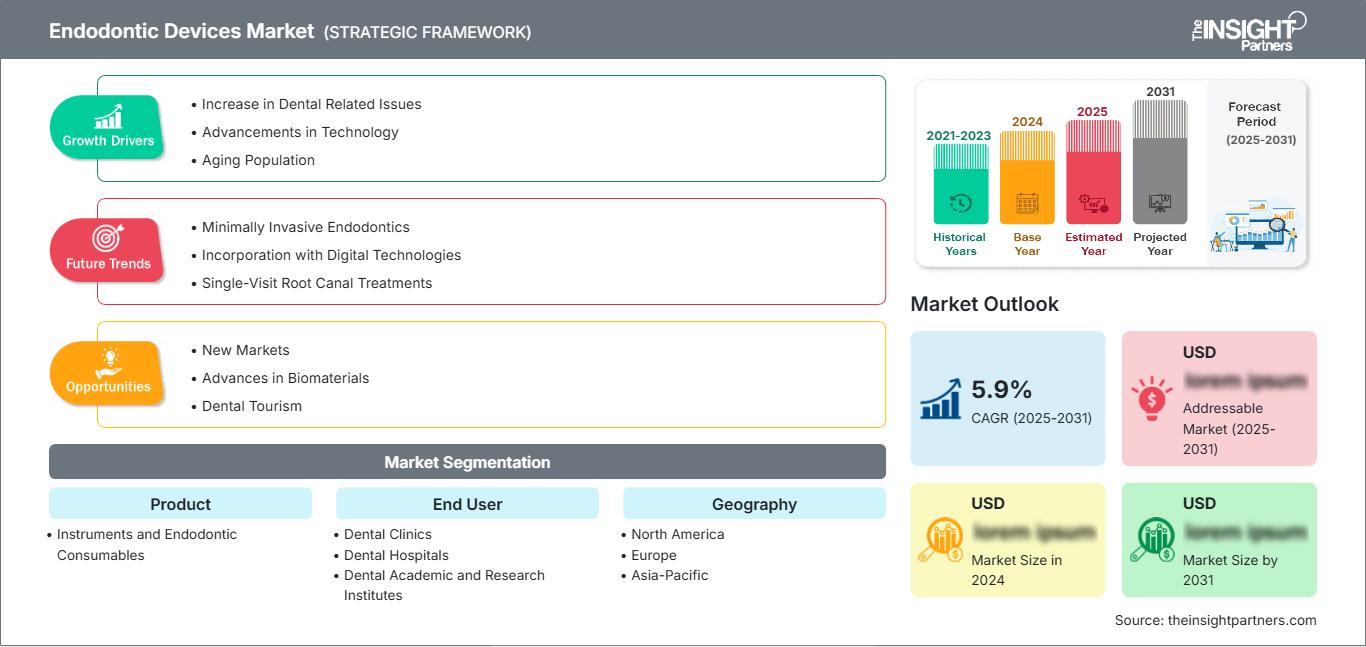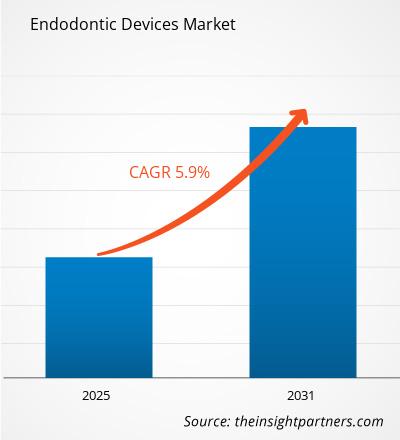The Endodontic Devices Market size is expected to reach US$ 2.57 billion by 2031. The market is anticipated to register a CAGR of 4.4% during 2025-2031.
The report is segmented by Product (Instruments and Endodontic Consumables). The report further presents analysis based on the End User (Dental Clinics, Dental Hospitals, and Dental Academic and Research Institutes). The global analysis is further broken-down at regional level and major countries. The Report Offers the Value in USD for the above analysis and segments.
Purpose of the Report
The report Endodontic Devices Market by The Insight Partners aims to describe the present landscape and future growth, top driving factors, challenges, and opportunities. This will provide insights to various business stakeholders, such as:
- Technology Providers/Manufacturers: To understand the evolving market dynamics and know the potential growth opportunities, enabling them to make informed strategic decisions.
- Investors: To conduct a comprehensive trend analysis regarding the market growth rate, market financial projections, and opportunities that exist across the value chain.
- Regulatory bodies: To regulate policies and police activities in the market with the aim of minimizing abuse, preserving investor trust and confidence, and upholding the integrity and stability of the market.
Endodontic Devices Market Segmentation Product
- Instruments and Endodontic Consumables
End User
- Dental Clinics
- Dental Hospitals
- Dental Academic and Research Institutes
You will get customization on any report - free of charge - including parts of this report, or country-level analysis, Excel Data pack, as well as avail great offers and discounts for start-ups & universities
Endodontic Devices Market: Strategic Insights

-
Get Top Key Market Trends of this report.This FREE sample will include data analysis, ranging from market trends to estimates and forecasts.
Endodontic Devices Market Growth Drivers
- Increase in Dental Related Issues: The growing cases of dental issues, such as caries and pulp infection, are further increasing the demand for endodontic devices. The development of tooth decay at older age and the widening awareness of oral care are driving the root canal treatments in several parts and thus contributing to the endodontic solution market.
- Advancements in Technology: Progress in endodontic instruments such as rotary instruments, apex locators, and advanced imaging improves the precision and efficiency in the treatment of root canals. As these ensure less time taken to treat patients with better results, more practitioners will use them, fueling an increase in the endodontic devices market.
- Aging Population: The graying population globally contributes to the importance of the endodontic device market since the older the population, the more liable they are to tooth decay and periodontal diseases. As life expectancy increases, so does the demand for dental care, such as root canal treatments, resulting in increased product development in the endodontic device market, particularly in developed countries.
Endodontic Devices Market Future Trends
- Minimally Invasive Endodontics: The trend is more towards minimally invasive endodontic treatments, using advanced apparatuses and approaches to preserve tooth structure. Less traumatic treatments are also appealing to the patient and the practitioner; therefore, it is sensible that the design of the endodontic tools improve accuracy and efficiency.
- Incorporation with Digital Technologies: This is due to the rapid acceptance of digital technologies, like 3D imaging and CAD/CAM systems that give a strong basis for diagnosis, appropriate treatment planning, and predictive outcome. The application of these technologies has improved the success rate of procedures in the field of endodontics, contributing to an increase in demand for digital-compatible devices.
- Single-Visit Root Canal Treatments: With a goal to create more accessible care and fewer appointments, the need for same-day root canals is increased. The end itself-for instance, high-speed rotary files-is part of the contribution that advanced technology gives endodontic equipment, and the better techniques used in obtaining allow for the completion of procedures in shorter times.
Endodontic Devices Market Opportunities
- New Markets: Opportunities also lie in the rapidly growing health care infrastructure across emerging markets in India, China, and Brazil. As awareness about dental care grows and modern treatments become more accessible, manufacturers are looking to penetrate regions with efficient endodontic devices at affordable prices. This growth is being driven by a combination of factors such as rising disposable incomes, government healthcare initiatives, technological advancements, and an increasing focus on preventive healthcare.
- Advances in Biomaterials: The development of new endodontic biomaterials, which comprises bioactive root canal sealers and regenerative pulp treatments, presents a superb opportunity. These materials can potentially deliver enhanced healing and outcomes in root canal treatment responses to the patients' needs for more efficient and long-lasting dental solutions, thus contributing to market growth.
- Dental Tourism: An increased number of dental tourisms goes on in countries offering cheap yet quality dental care services. With this trend, more opportunities are exposed to the endodontic devices market because the patients belonging to developed nations are on a search for cheaper treatment routes outside the country. Dental practices in these regions are likely to increase their investment in advanced endodontic tools and equipment to attract international clients.
The regional trends and factors influencing the Endodontic Devices Market throughout the forecast period have been thoroughly explained by the analysts at The Insight Partners. This section also discusses Endodontic Devices Market segments and geography across North America, Europe, Asia Pacific, Middle East and Africa, and South and Central America.
Endodontic Devices Market Report Scope
| Report Attribute | Details |
|---|---|
| Market size in 2024 | US$ XX Billion |
| Market Size by 2031 | US$ 2.57 billion |
| Global CAGR (2025 - 2031) | 4.4% |
| Historical Data | 2021-2023 |
| Forecast period | 2025-2031 |
| Segments Covered |
By Product
|
| Regions and Countries Covered |
North America
|
| Market leaders and key company profiles |
|
Endodontic Devices Market Players Density: Understanding Its Impact on Business Dynamics
The Endodontic Devices Market is growing rapidly, driven by increasing end-user demand due to factors such as evolving consumer preferences, technological advancements, and greater awareness of the product's benefits. As demand rises, businesses are expanding their offerings, innovating to meet consumer needs, and capitalizing on emerging trends, which further fuels market growth.

- Get the Endodontic Devices Market top key players overview
Key Selling Points
- Comprehensive Coverage: The report comprehensively covers the analysis of products, services, types, and end users of the Endodontic Devices Market, providing a holistic landscape.
- Expert Analysis: The report is compiled based on the in-depth understanding of industry experts and analysts.
- Up-to-date Information: The report assures business relevance due to its coverage of recent information and data trends.
- Customization Options: This report can be customized to cater to specific client requirements and suit the business strategies aptly.
The research report on the Endodontic Devices Market can, therefore, help spearhead the trail of decoding and understanding the industry scenario and growth prospects. Although there can be a few valid concerns, the overall benefits of this report tend to outweigh the disadvantages.
Frequently Asked Questions
What is the expected CAGR of the endodontic devices market?
Which region is expected to witness the fastest growth rate by 2031?
What are the driving factors impacting the endodontic devices market?
Which are the leading players operating in the endodontic devices market?
What are the future trends of the endodontic devices market?
Which region dominated the endodontic devices market in 2023?
- Historical Analysis (2 Years), Base Year, Forecast (7 Years) with CAGR
- PEST and SWOT Analysis
- Market Size Value / Volume - Global, Regional, Country
- Industry and Competitive Landscape
- Excel Dataset
Recent Reports
Testimonials
Reason to Buy
- Informed Decision-Making
- Understanding Market Dynamics
- Competitive Analysis
- Identifying Emerging Markets
- Customer Insights
- Market Forecasts
- Risk Mitigation
- Boosting Operational Efficiency
- Strategic Planning
- Investment Justification
- Tracking Industry Innovations
- Aligning with Regulatory Trends





















 Get Free Sample For
Get Free Sample For